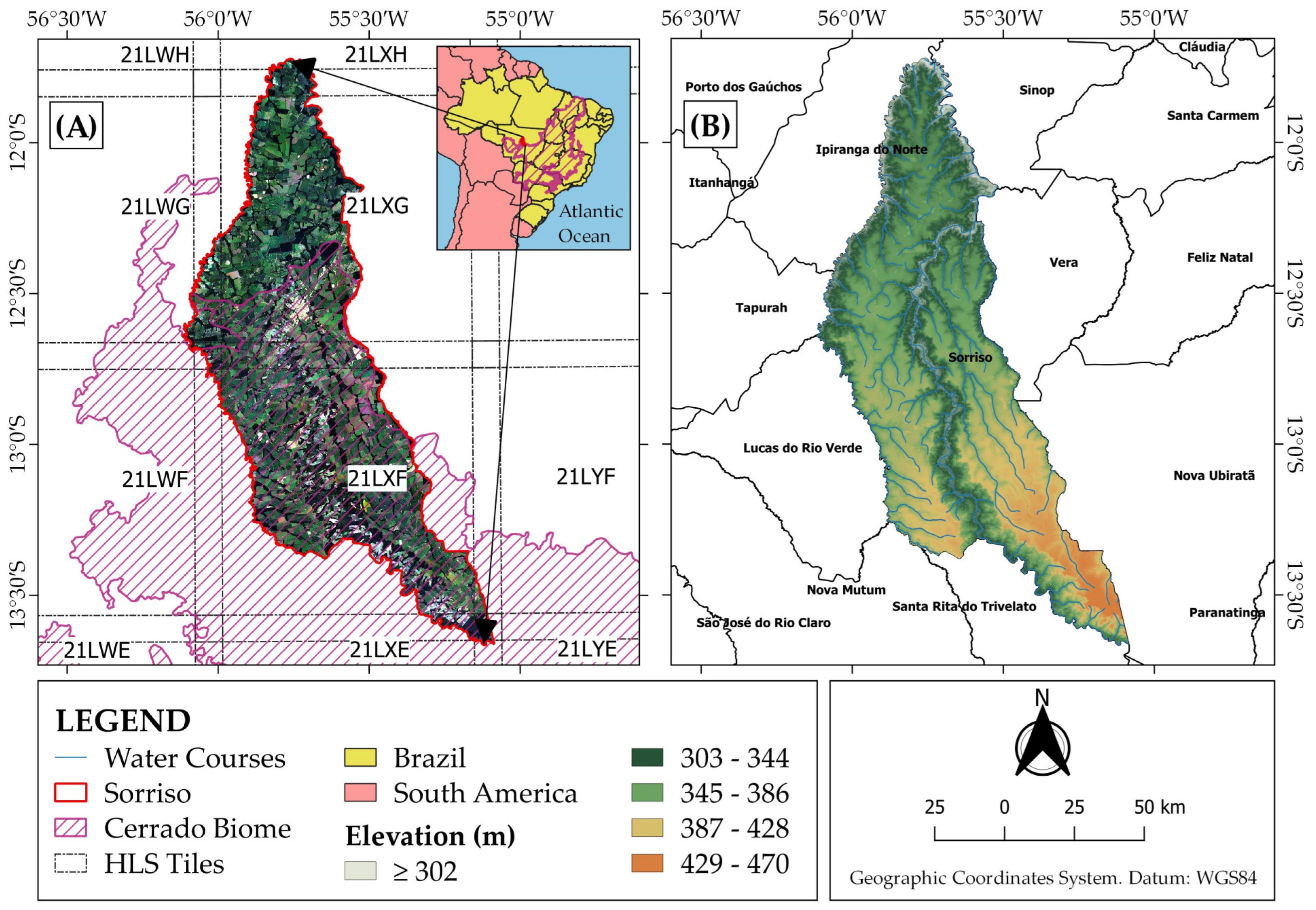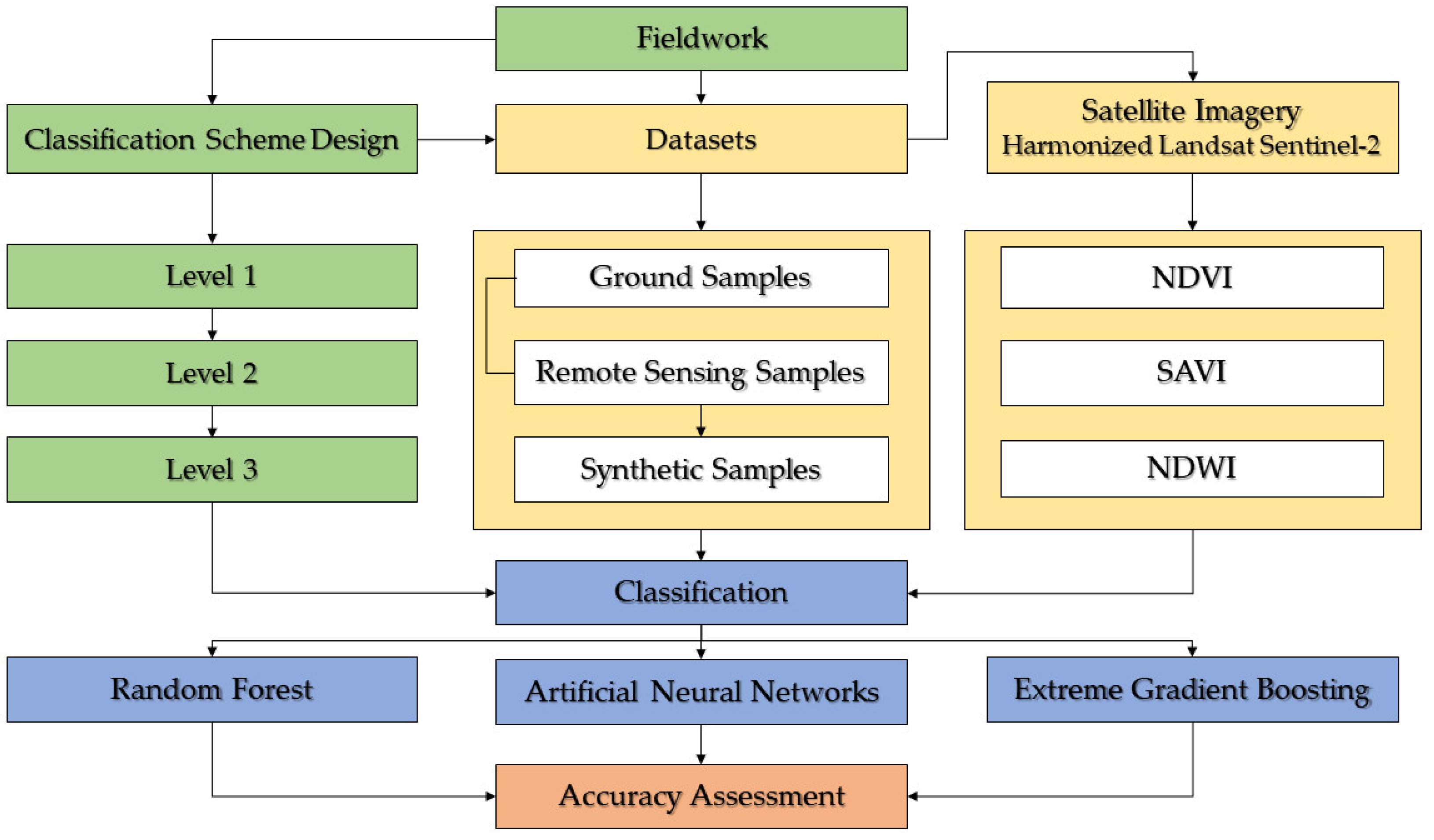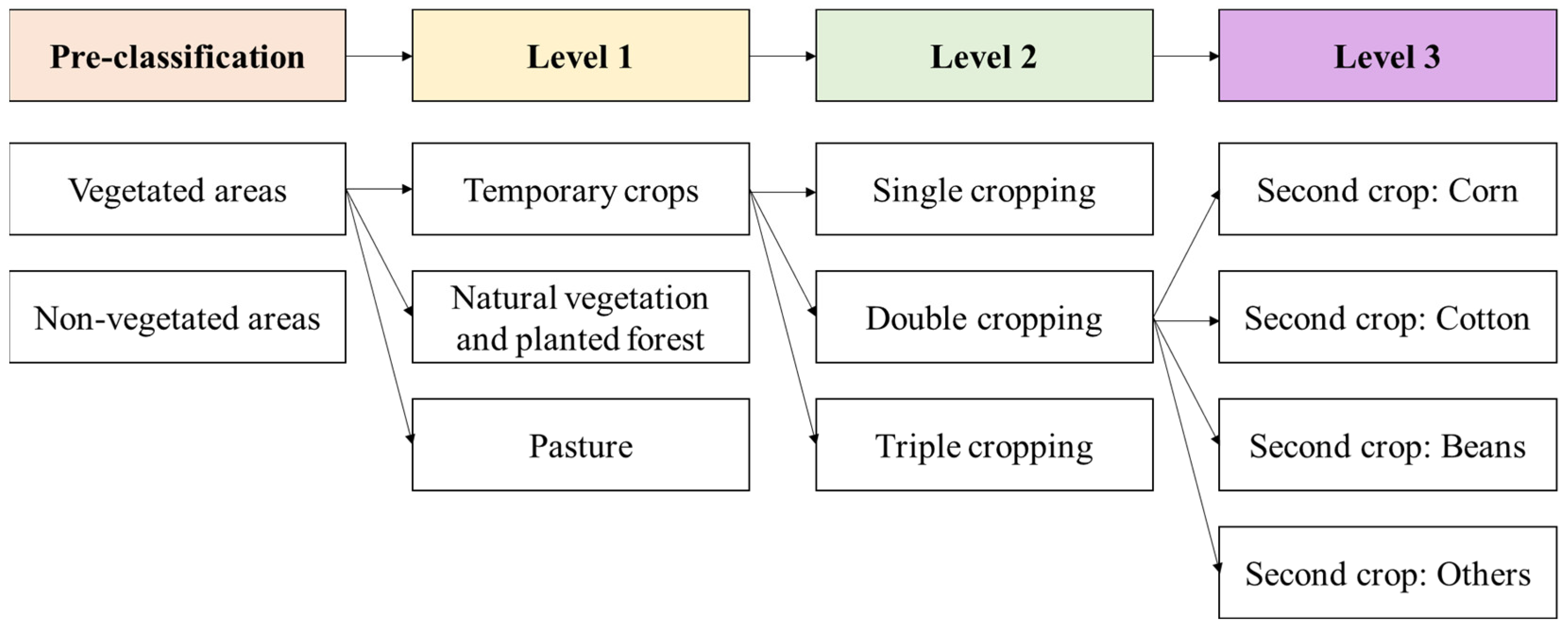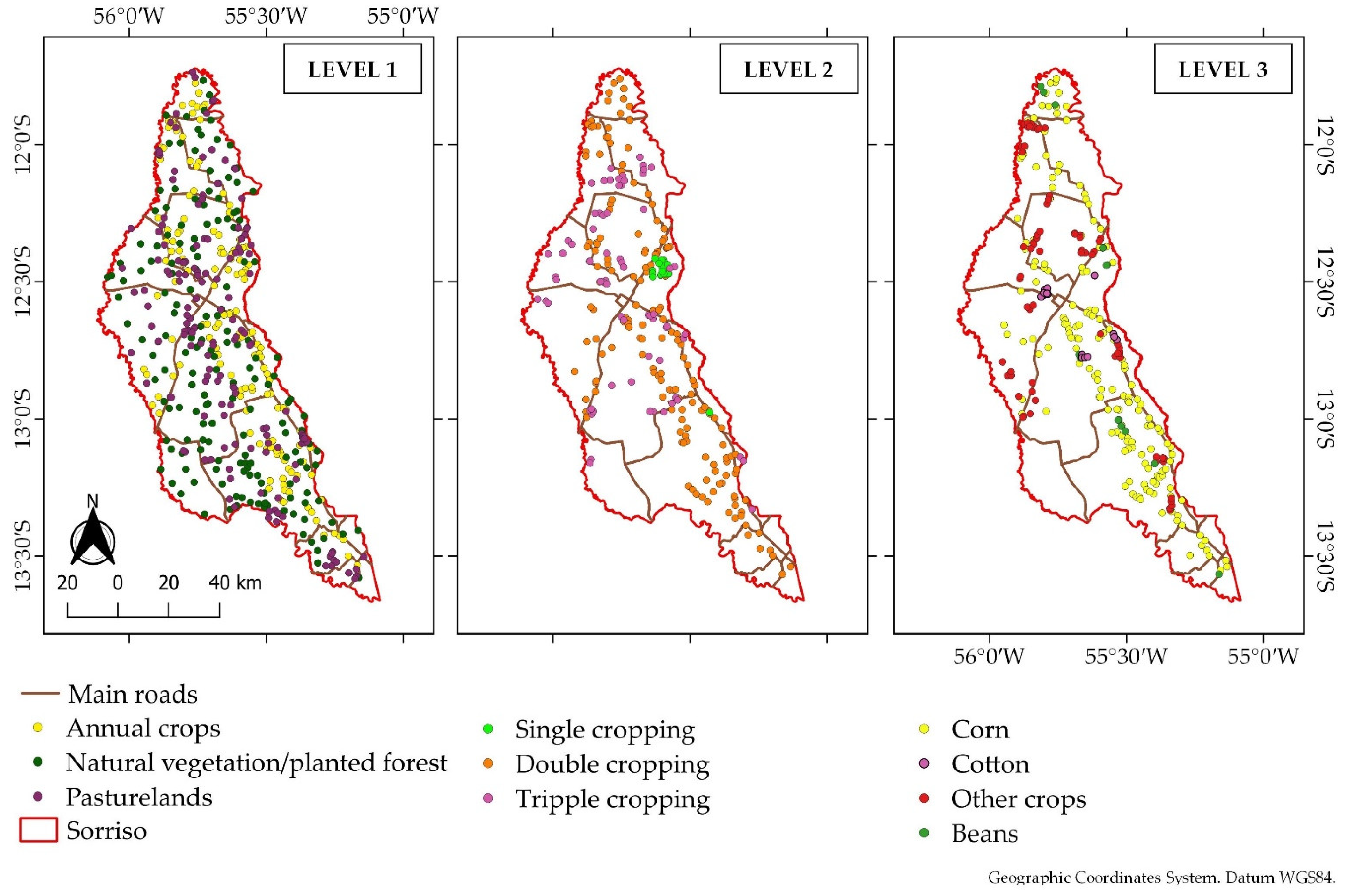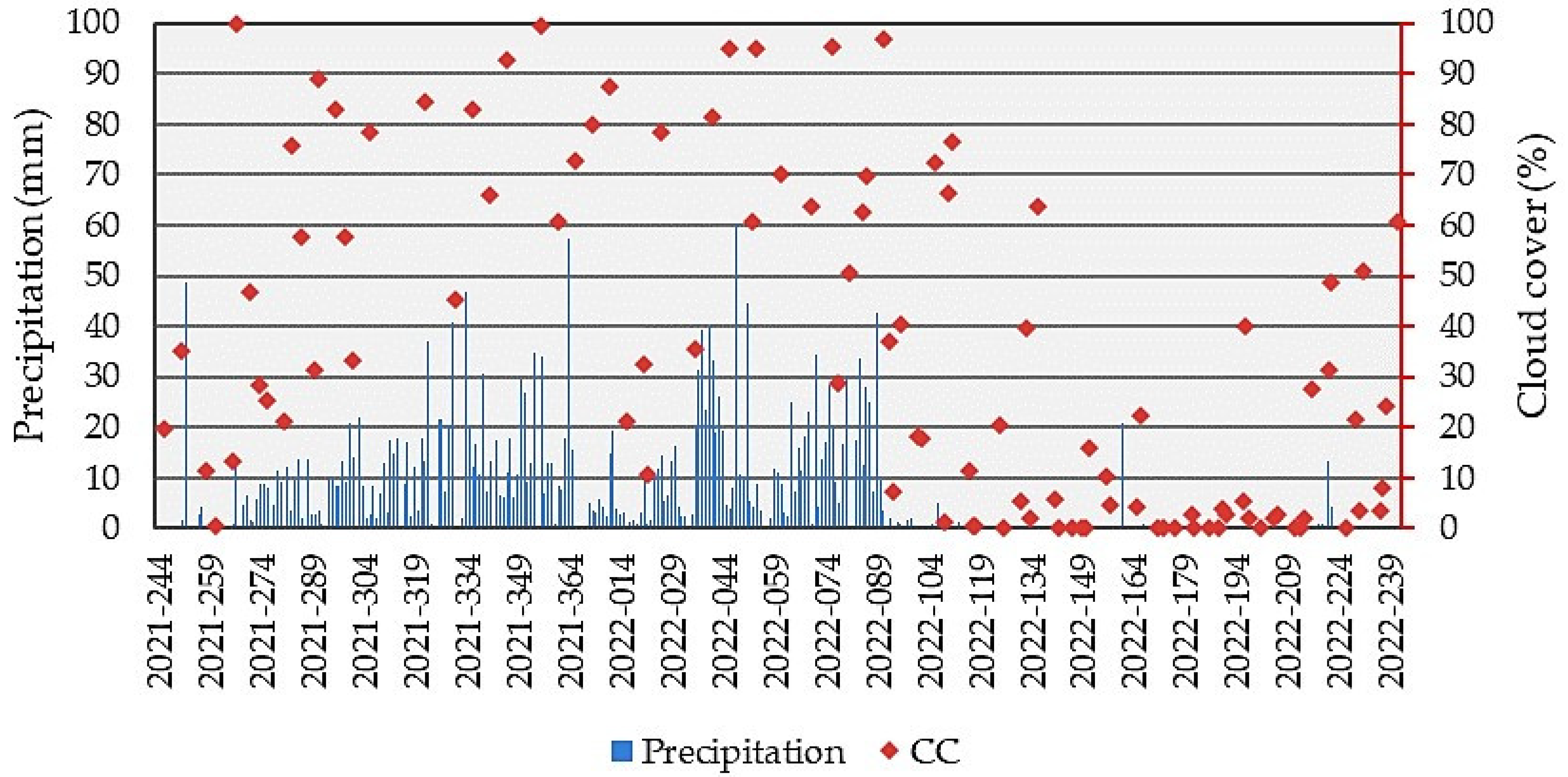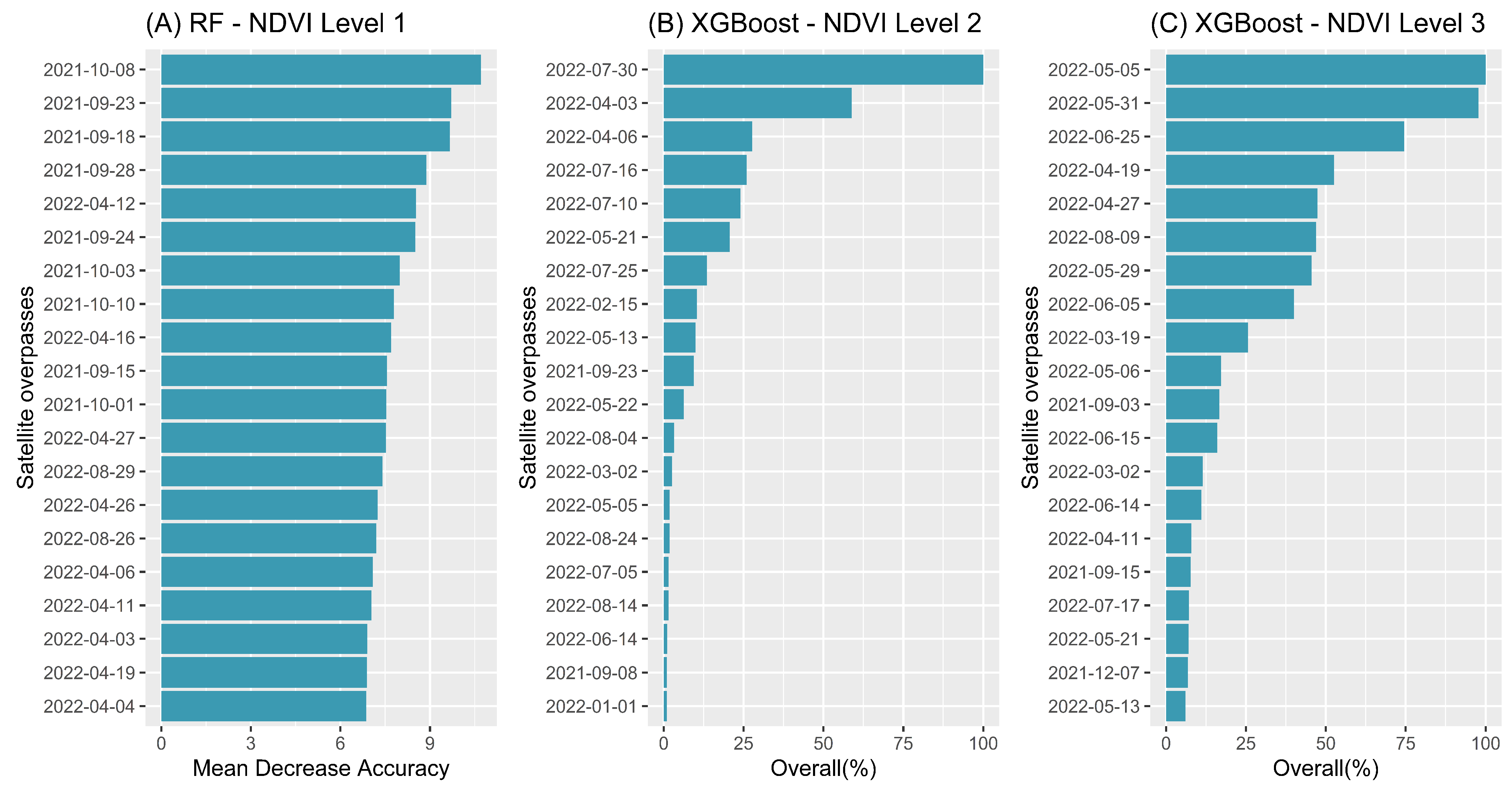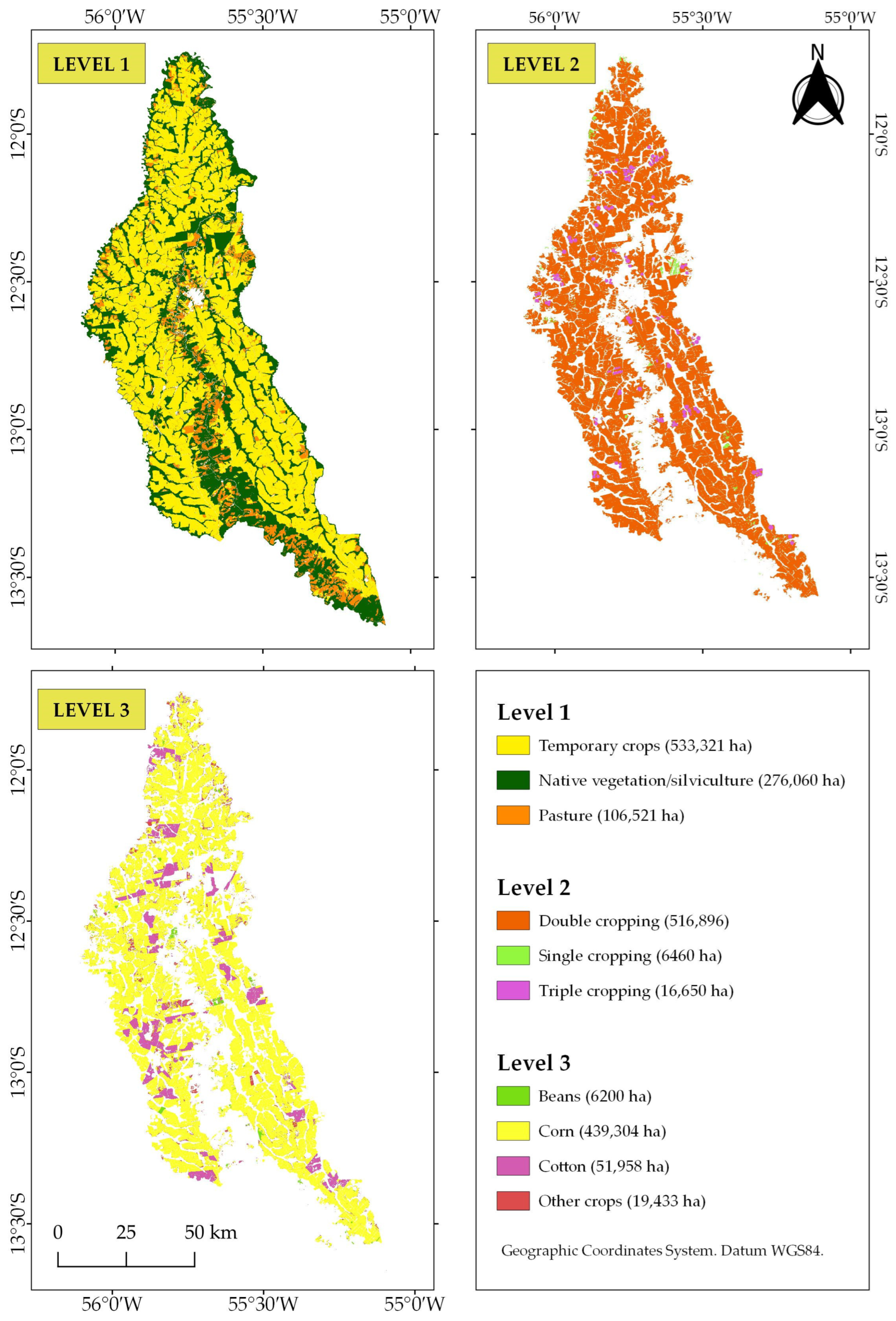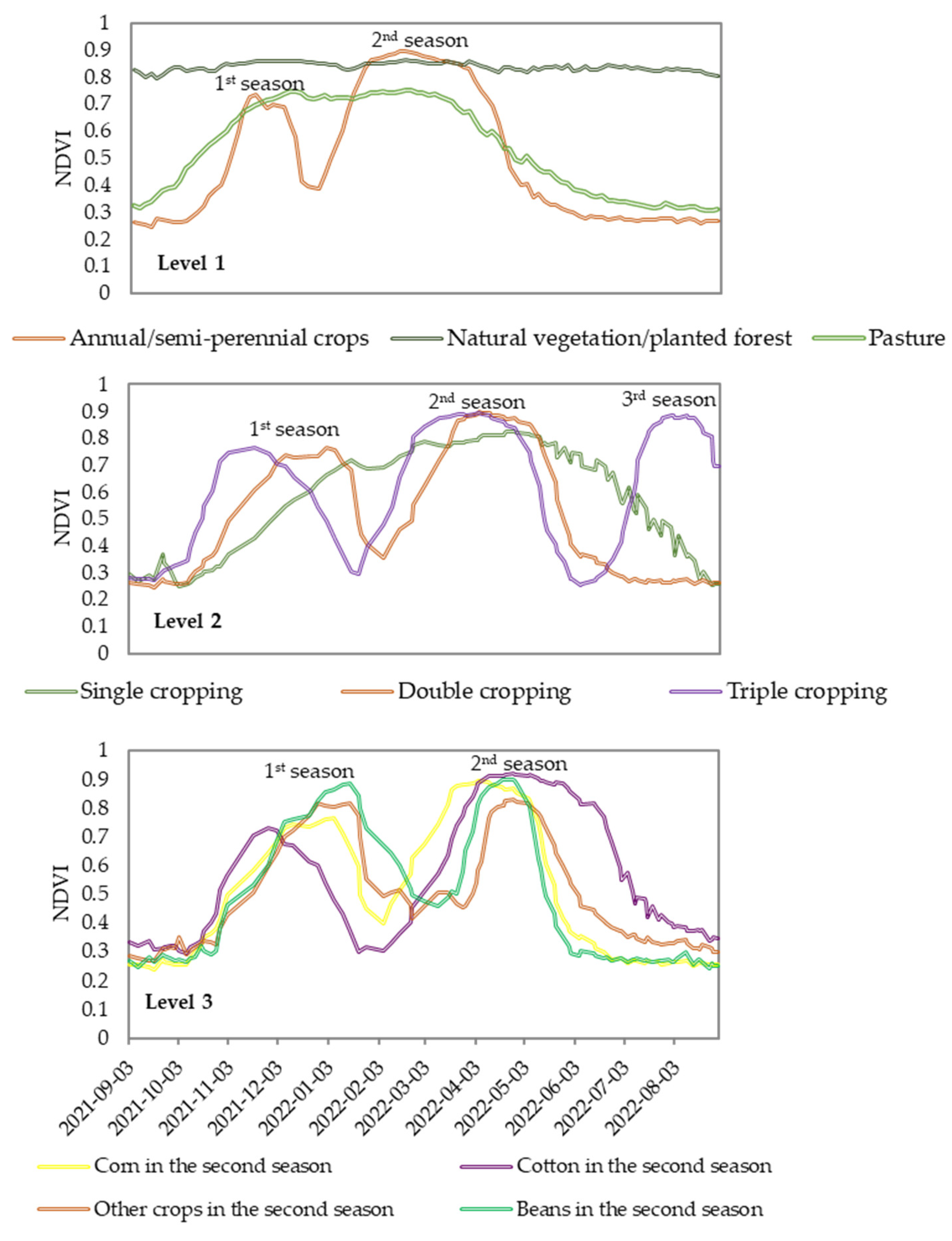2.2. Remote Sensing Data Sets
This study was based on spectral indices derived from HLS images processed by spatial, temporal, and band filters [
18]. The HLS Landsat OLI images converted into surface reflectance and top-of-atmosphere (TOA) brightness data (HLS.L30) and the HLS Sentinel-2 MSI images converted into surface reflectance (HLS.S30) were downloaded from NASA’s Application for Extracting and Exploring Analysis Ready Samples (AρρEEARS) data access platform. All available surface reflectance data from red (R) (640–670 nm), near-infrared (NIR) (850–880 nm), and shortwave infrared (SWIR) (1570–1650 nm) wavelengths were acquired within the limits of the study area at a 30 m spatial resolution between September 2021 and August 2022. Whenever HLS.L30 and HLS.S30 overpasses coincided, we selected the latter.
The HLS data set is produced by NASA through the following processing chain: atmosphere correction, spatial co-registration, Bidirectional Reflectance Distribution Function (BRDF) normalization, and bandpass adjustment [
18]. The atmosphere correction involves the use of the Land Surface Reflectance Code (LaSRC) based on the 6S radiative transfer code [
34]. The Automated Registration and Orthorectification Package [
35] is used to perform the spatial co-registration between Landsat OLI and Sentinel-2 MSI images to the same reference per tile. The c-factor technique and global coefficients are used to reduce the sun sensor geometry effects by estimating BRDF and Nadir BRDF-adjusted reflectance with scattering models [
36,
37]. Finally, differences between MSI and OLI equivalent bands are adjusted by linear fit using slope and offset coefficients generated with 160 global hyperion scenes [
18].
The images were additionally processed using R statistical software [
38] to apply the scale factor (0.0001), cloud masking, gap filling, and generation of the spectral indices. Initially, the original HLS quality assessment band (Fmask) removed pixels flagged with cloud, cloud shadow, cloud shadow adjacencies, and water. Therefore, only the integer values 64, 128, and 192, representing clean pixels and the medium aerosol limit, were kept. It was necessary to use pixels with this limit to reduce the amount of data lost since Fmask tends to overestimate aerosol levels (see the users’ guide [
39] for full details on HLS cloud masking). HLS.L30 and HLS.S30 images were stacked, and the gaps created in the multispectral time series by the cloud masks were filled by simple linear interpolation across layers using the “raster” package [
40].
Finally, we calculated the following spectral indices: the NDVI, NDWI, and SAVI (see equations in
Table 2. In general, agricultural intensification studies are carried out using MODIS products, so the EVI and NDVI are readily available. The selected spectral indices capture the phenological dynamics of crop cycles well [
8,
10,
41]. The NDVI is the most popular vegetation index used for mapping land use and land cover (LULC) and a wide range of other applications since it is related to photosynthetic activity [
42]. The SAVI is less sensitive to soil background effects than the NDVI and has proven to be a valuable variable for agriculture mapping in previous studies (e.g., Parreiras et al. [
14]). The NDWI considers a SWIR band that is sensitive to the leaf water content and biochemical component variation among several vegetation types, which can be an advantage for differentiating between classes with similar spectral responses in the NIR and red domains [
43]. The combined use of the three spectral indices was also evaluated, henceforth referred to as All VI.
2.3. Methodological Approach
The main steps of our methodological approach were (i) fieldwork for the selection of samples; (ii) creation of synthetic samples; (iii) elaboration of the hierarchical classification scheme; (iv) obtaining the HLS data set and generating spectral indices; (v) training ML algorithms for classification; and (vi) accuracy assessment (
Figure 2).
To assess agriculture intensification and second-season crop types in Sorriso, we conducted a field campaign from 6 to 9 June 2022, which corresponded to the end of the second crop season as well as the start of the third season for irrigated crops. We gathered 318 randomly distributed ground samples with the support of the AgroTag mobile application developed by Embrapa [
47]. AgroTag provides structured queries to allow the storage of detailed, georeferenced ground sample information, as well as panoramic and nadir field photos (
Figure 3).
Based on field information, a hierarchical classification scheme was adopted to discriminate the main LULC classes found in Sorriso (
Figure 4). Initially, we created a mask to distinguish areas with vegetation, including natural and agricultural land, and areas without vegetation. Data from the MapBiomas Project [
48,
49] were used to delineate the pixels corresponding to all non-vegetated areas (urban, mining, water, and others). Highways were excluded based on the cartographic database from the Instituto de Terras de Mato Grosso at a 1:100,000 scale [
50]. A 30 m buffer was used to represent road width and consequently carry out the extraction. From this procedure, all non-vegetated pixels were masked out, and level 1 classification was performed on the remaining vegetated areas.
In the level 1 classification procedure, we differentiated the study area into areas containing (i) temporary crops, (ii) natural vegetation and planted forests (or silviculture), and (iii) pasturelands. Planted forests were mapped together with the natural vegetation because of their low occurrence in the study area. Then, we divided the temporary crops based on the number of cycles, including single, double, or triple cropping (level 2). Sugarcane was classified as a single crop, while triple cropping was exclusively observed in center-pivot irrigation systems, mainly with beans as the third-season crop. Although all triple cropping was related to center pivots, not all center pivots were related to triple cropping. Finally, at level 3, double cropping areas were categorized into corn, cotton, beans, and other crops, that is, mainly sorghum and millet. These crops were grown in the second season, mainly following the soybean harvest.
Even though there is substantial progress regarding satellite image availability and non-parametric, supervised classification algorithms, the acquisition of balanced ground sample data sets is still a challenge in LULC mapping procedures. The imbalance of reference data sets significantly affects image classification [
51]; however, the sampling must be representative of the occurrence of LULC classes [
52]. In this study, we faced a bias toward the high occurrence of double cropping with corn as a second crop. It represented approximately 50% of the total number of samples.
Therefore, additional samples of natural vegetation, pastures, planted forests, sugarcane, and triple cropping were collected remotely using a high-resolution Norway’s International Climate and Forest Initiative (NICFI) PlanetScope monthly mosaic (Imagery © 2022 Planet Labs Inc., San Francisco, CA, USA), an HLS 30 m RGB false color composite of bands 8, 4, and 3, and the temporal NDVI profile from the MODIS sensor available in the SatVeg platform developed by Embrapa Agricultura Digital [
53]. The elements and interpretation keys that guided the sample selection are described, with examples, in the
Supplementary Materials.
Table 3 summarizes the final number of samples used for further ML classification.
At levels 2 and 3, the method known as the Synthetic Minority Oversampling Technique (SMOTE) was used to increase the number of samples of minor classes, that is, classes with less than 15% occurrence in a specific level, by generating synthetic samples. The SMOTE is the most popular algorithm to deal with imbalance problems in LULC classification [
44], and it was implemented using the “scutr” package [
54] in R software, version 4.2.2 [
38]. Before creating synthetic samples, we carried out a quality control process to check the correctness of every ground sample point with HLS color compositions from the same period of the field visit.
Table 4 summarizes the final number of samples used for further ML classification at levels 2 and 3, while
Figure 5 exhibits the spatial distribution of the sampling points used in each level.
The methodological structure was set up using “Caret” and “randomForest” packages [
55,
56] in the R environment [
38]. We considered the samples of LULC classes as the y variables to be predicted and the satellite image time series database (NDVI, SAVI, and NDWI) as the x predictor variables. We evaluated the following supervised classification algorithms: XGBoost [
57], ANN [
58] (both available in the Caret package), and RF [
56] (using the randomForest package). We used a 70%/30% ratio to split the data sets into training and test subsets for level 1. Due to the smaller number of observations in some classes, a ratio of 60%/40% was adopted for levels 2 and 3.
RF is a decision tree model that uses the bootstrap method. More specifically, it creates several sets of trees with different variables to decrease the correlation between the trees to avoid overfitting in the predictions. Each tree presents a prediction, and the final prediction is given by considering the voting rules for each class mapped in the trees [
59]. The main RF hyperparameters to be adjusted are the mtry, i.e., the number of features drawn for the split, and the number of trees in the forest (nTree). XGBoost is also a model based on decision trees; however, while RF uses the bootstrap method, XGBoost works with boosting, in which trees with weak predictions are improved over time. The final classification is based on improving trees through iterative processes [
57]. The XGBoost hyperparameters to be adjusted are nrounds, lambda, and alpha.
The ANN is a model inspired by the neurological behavior of the human brain. The neural network is composed of layers, which comprise prediction phases. In the first phase, there is the input layer, responsible for presenting the neural network with the training variables and their behavior patterns. The second phase is where all the processing occurs, i.e., the model training stage, known as hidden layers. Finally, there is the output layer, where the result of the prediction is provided [
58]; in our case, the prediction is the agricultural intensification classes. Size and Decay are the hyperparameters in the ANN model. All models were trained and the hyperparameters were automatically tuned through a grid search cross-validation with 5 folds and 10 repetitions.
To assess the model performances, we considered the confusion matrices and their corresponding metrics of overall accuracy (OA), which refers to the rate of correct answers in relation to the total number of samples, and the kappa index, which refers to the degree of agreement between the classification results and the reference data. Additionally, to assess class accuracies, we also considered errors of omission (OEs; samples that were not classified according to the reference classes in the rows of the matrix) and commission errors (CEs; reference samples misclassified as belonging to other classes in the columns) [
60].
The model results were subjected to analysis of variance (ANOVA) to assess possible statistical differences after the Shapiro–Wilk normality test. The importance of model variables was evaluated using the VarImp function. For the RF algorithm, the importance was given by the Mean Decrease Accuracy (MDA), while for XGBoost and ANN, we considered the relative importance, that is, Overall%. MDA measures the impact of changing the variable of interest on model accuracy. In the Overall%, the importance values were scaled from 0 to 100, with the least important variables close to 0 and the most explanatory close to 100. The results of this study were also analyzed in comparison to similar studies, mainly those carried out in the Brazilian savanna, to identify the advances brought by the proposed approach.
